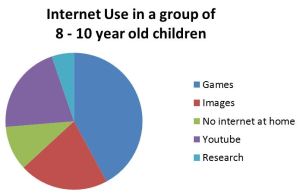
“Screen Time” – the amount of time spent in front of media such as television, games and computers – is a controversial issue. Both the American Academy of Pediatrics (2010) and the CSIRO (2013) recommend that for health reasons, children should spend less than 2 hours per day in front of a screen. However, Sweetser, Johnson, Ozdowska, & Wyeth,(2012, p. 95) argue that these recommendations do not take into account the different ways children spend their screen time, and that cognitively and physically engaging in ‘active screen time’ should be classed differently to more passive activities such as watching television.
So what about the children in my class? How are they spending their screen time?
This week, I investigated the popular culture influences on my class of 8-10 year old students, with particular focus on how they spend their ‘screen time’ – time in front of the TV, movies, computers and devices such as tablet computers.
I asked the students in my year 3/4 class about what they liked to watch on TV, what their favourite movies and games were, and how they spent their time on the Internet.
The most surprising thing I found was the sheer diversity of answers. There were few students who wrote down the same answers – there was a huge range of favourite TV shows, movies and games.
Television
The children in my class cited a very diverse range of favourite television shows. Animated shows were popular, with many children explaining that these are their favourites because they are “funny”. These shows included Adventure Time, Kids WB, Phineas and Ferb and Pokemon. Also included were television shows I would consider inappropriate for the age group, such as Family Guy. A smaller number of students cited drama programs such as H20: Just Add Water and Dance Academy. Other types of programs mentioned were reality shows such as Big Brother and Wheeler Dealers, as well as ‘educational’ programs such as Backyard Science. Only 2 students mentioned watching sport on TV, with both citing Soccer as a favourite program to watch.
Movies/DVDS
Once again, I was surprised by the sheer diversity of movies mentioned by students in my class as their ‘favourites’. The only movie which came up more than once was Despicable Me, which was cited as a favourite by 3 children. The remaining students mentioned a mixture of different genres, including action (The Wolverine), animated movies (Epic, The Incredibles), fantasy (Harry Potter, Lord of the Rings) and drama (Pitch Perfect, Australia). Once again, children mentioned movies which I felt to be inappropriate for their age group, such as Ted.

Games
On the survey I used, I asked my class “What is your favourite game, and why?” which produced some very interesting and varied results. Students interpreted this question in different ways. Some students wrote down computer games (with Minecraft and Naruto Shippuden being the most popular), while others wrote down more traditional or party games, like Pass the Parcel or Fruit Salad. Still others mentioned sports like softball or board games like Monopoly. It would be interesting to see what the results would have been if I had asked a more specific question about computer games.
Internet Use
Internet use by students in my class could be broken into 3 main categories: Games, Images and YouTube.

The most common use for the internet was games, followed closely by searching for images using Google and watching videos on YouTube. Of those students who answered this question (some left it blank), two students said they had no internet access at home, and only one student mentioned using the internet for research or schoolwork.
When asked about what sort of videos they liked to watch on YouTube, students again provided a wide diversity of answers. Several students mentioned looking up videos of their favourite movies and television shows. Popular choices also included tutorials (particularly Minecraft tutorials), music videos and ‘funny videos’ (such as funny cats, Fred, and The Annoying Orange).
Conclusions
Conducting a survey such as this one posed more questions for me than it answered. With such a huge diversity how students spend their screen time, what do we really mean by the term “popular”? If a larger sample size were used, how would the results have varied? How many students are regularly viewing inappropriate material?
Nonetheless, I found this to be a very worthwhile exercise. Hunt & Hunt (2004, p. 82) suggest that teachers who want to build connections with their students should “spend time in their cultural worlds”. I certainly feel I know my students a little better after asking them about their interests.
What are your thoughts?
How similar are these results to your own children’s (or children your work with) interests? Have you noticed a similar diversity?
American Academy of Pediatrics. (2010). Media Education. Pediatrics, 126(5), 1012-1017. doi: 10.1542/peds.2010-1636 CSIRO. (2013). Recreational Screen Time. Retrieved September 24, 2013, from http://www.csiro.au/Outcomes/Health-and-Wellbeing/Prevention/10-steps-for-healthy-families-ScreenTime.aspx Hunt, T., & Hunt, B. (2004) Popular Culture: Building Connections with Our Students. English Journal, 93(3), 80-83. Retrieved from http://www.jstor.org.ezp01.library.qut.edu.au/stable/4128814 Sweetser, P., Johnson, D. Ozdowska, A., & Wyeth, P. (2012). Active versus passive screen time for young children. Australasian Journal of Early Childhood 37(4), 94-98. Retrieved from http://search.informit.com.au.ezp01.library.qut.edu.au/fullText;dn=195789;res=AEIPT
I found it very interesting to view the concept of screen time/ leisure time/engagement with popular culture though the lens of primary school students. Many of my students are frequently involved with popular cultural experiences such as South Park, Beevas and Butthead, Call of Duty and The Hangover… Thus I am dreading the start of the new term due to the recent release of the new Grand Theft Auto….
Yet no matter the platform, the content or the students age the concepts contained in the students screen time are now forever embedded into our cultural history. Thus it remains a relevant fact that this leisure experience has significant impact on our students and their understanding. Ultimately we as teachers need to take their interests and involvement with popular culture seriously to ensure students are supported in remaining engaged in their formal education.
Essentially the lessons I am learning during this course is the fact that while popular culture and screen time offer students an alternate method to access information and learning their involvement needs to monitored even if only on an informal level. Our interest in and use of the popular culture that engages our students will allow us to explicitly link the lessons learnt in popular culture to the necessities of social participation. Many of the concepts contained within some of these aspects of popular culture are designed for a mature audience and while I believe that children only recognized constructs that apply to their understandings there needs to be someone that they can turn to when a question arises from their exposure.
Ultimately the youth of today are embracing the various cultural expressions and experience open to them and as a result their exposure is ongoing and growing expeditiously. Thus it is up to the adults in their world to teach them how to critically judge and question the information, images and concepts contained in the items they engage with, for although it is not academically rigorous it is relevant and accessible. We are not to be the censors… but perhaps if not the gate keepers (that ultimately is the parent’s job) then at least the guides.